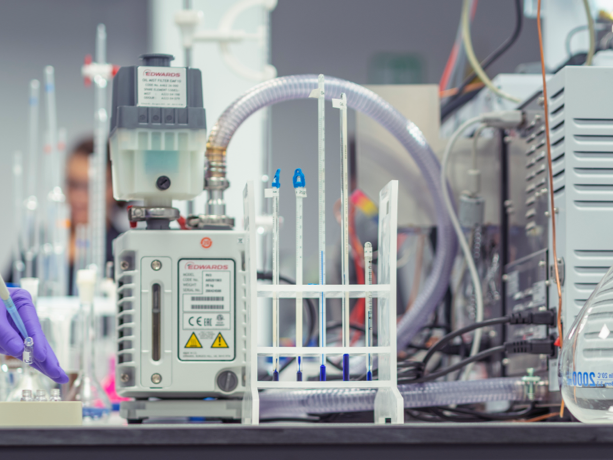What Is Scanning Electron Microscopy?

Microscopes are arguably one of the most important technological inventions in the scientific world. But, they’ve come a long way from using glass lenses to magnify objects that are otherwise indistinguishable or invisible to the naked eye. Microscopy as a field has continued to improve, and advancements such as Advanced Digital Microscopy, or Scanning Electron Microscopy (SEM), have had their own impact on the field.
It would be remiss for us to try and explain each of these technologies in the same article; as such, we’ve decided to begin with one of the most common: Scanning Electron Microscopy. In this guide, we will explain what Scanning Electron Microscopy is, how it works, and just why the results derived from it can be so valuable to specific industries.
Keep reading to learn more…
What is Scanning Electron Microscopy?
One of the fortunate things about many technologies is that their names are often indicative of what they do. In this case, Scanning Electron Microscopy can be distilled into the concept of using electrons to scan the surface of a sample in order to create high-resolution digital images. Using this technology, scientists and researchers can gain a deeper understanding of miniscule abrasions, changes, and fail points of a sample.
How does SEM work?
Unlike optical microscopes that use light to improve the resolution of an image, SEM utilises a beam of high-energy electrons to generate even higher-resolution images of a sample. To put it simply, the electrons within the beam collide and interact with the surface of a sample, producing a variety of signals, such as:
- Secondary electrons: produced relatively closely to the sample, the information used from secondary electrons is useful for morphological (structural) and topographical contrast of a sample.
- Backscattered electrons: reflecting back out of a sample, the readings from backscattered electrons are valuable for understanding material composition.
- Diffracted backscattered electrons: similar to the above, these are found when the backscattered electrons interact with a crystalline structure, causing them to spread out again.
- Photons: while not directly involved in the imaging, the characteristic x-rays can be measured to help identify chemical composition (especially when using a technique called “cathodoluminescence”).
Each collision causes the electrons to “lose” energy. According to the Law of Conservation of Energy, energy cannot be destroyed nor created – but it can be transformed into a different type. In this case, after a collision, x-rays are released in a fixed wavelength that corresponds to the difference in energy states, which is then “read” by specific computer technology within the SEM.
The anatomy of a Scanning Electron Microscope
In order to get the high-value images and results needed, Scanning Electron Microscopes are made up of the following main components:
An electron source
Perhaps the most obvious place to start; in order to use a SEM, you first need a source of electrons. This is more often referred to as an “electron gun” because it fires out a beam of electrons to collide with the surface of the sample. The choice of electron source is crucial, as for the tests to work the beam of electrons needs to be consistent and stable.
There are three primary types of electron sources used in Scanning Electron Microscopes, which are:
- Tungsten filaments: this is a type of thermionic emitter that uses resistive heat to overcome the work function to release electrons. Or, in simpler terms, an electrical current heats the tungsten filament to the point where electrons have enough energy to leave the material. Tungsten filaments are cost-effective, however they can burnout with repeated use (over 100 hours), and offer the least resolution for the final image.
- Solid state hexaboride crystals: using a similar principle as the above, instead of tungsten, some SEMs use solid hexaboride crystals (more specifically, either lanthanum hexaboride or cerium hexaboride). These are a popular choice for high-quality SEM instruments, as they emit a brighter beam for better signal-to-noise and resolution quality in the image.
- Field emission guns: for the highest-quality images, some SEMs use field emission guns. This electron source is made up of a heated tungsten crystal, with electrons extracted in greater numbers using the Schottky effect (which increases the discharge of electrons by using an electric field to reduce to energy required for them the move). This is the most expensive method, but provides the best image resolution.
Lenses
Once you have obtained a stable source of electrons, the next necessary step is to be able to manipulate the beam. Lenses are commonly used to redirect light, and it is similar in this case. Scanning Electron Microscopes make use of two different types of lens, which are:
- Condenser lens: as the name suggests, the main function of a condenser lens is to condense the electron beam. Using a series of these lenses, you can get a more focused, narrow stream of electrons.
- Objective lens: this is always the last lens in the microscope, and focuses the electron beam onto the sample.
X-Y scan coils and scan generator
After the beam diameter has been reduced by the lenses, and the focus is correct, it is free to travel towards the sample. But, in order to get a detailed image, a Scanning Electron Microscope uses X-Y coils and a scan generator to control the movement of the beam across a sample.
SEM uses raster scanning, which is where the beam moves horizontally across the sample to generate an image. The X-Y coils and generator dictate this movement and define the area of the sample surface that is being scanned.
Detectors
The readings from the test cannot be immediately inputted into a computer for scientists to use. A detector attracts the electrons that have been ejected from a sample and converts them into an electrical current that can be measured by a specific computer programme.
Note: there is a detector for each type of electron as described above.
A sample stage
Quite simply, this is where the sample is held during the analysis.
A computer and display
The detector is connected to a computer and display, which converts the electrical current it receives into a format which can be examined by researchers and scientists. SEM images are in black and white greyscale, which show the surface of the sample in high resolution. In these images, the surface of a sample can be magnified up to two million times, depending on the electron source, showing flaws, imperfections and other details that would be invisible to the naked eye.
External vacuum pump
To produce the necessary consistent, stable electron beam, Scanning Electron Microscopes have vacuum pumps to create the right conditions within the machinery. Many use two vacuum pumps, one for rough evacuation to create the initial conditions; and a further turbomolecular pump to refine the quality of the vacuum required.
What is Scanning Electron Microscopy used for?
As we’ve discussed, the purpose of a Scanning Electron Microscope is to generate high-quality, high resolution magnification images of the surface of a sample. But what can these images be used for?
We touched upon it briefly, but SEM is often used in forensic investigations to reveal details about sample surfaces that would otherwise go unnoticed. It can also be used in:
- Geological studies to identify surfaces and compositions of rocks.
- Biological and medical sciences, for cell and tissue structural analyses.
- Materials science, to analyse the structures and surfaces of metals and alloys, and the production of new materials to identify strengths and weaknesses.
Advantages and disadvantages
As with any type of technology, there are a variety of advantages and disadvantages to using Scanning Electron Microscopy. Some advantages to this technology are:
- Scanning Electron Microscopy is a non-destructive form of materials testing as it does not damage the sample in any way. This means the same sample can be tested multiple times without issue.
- This technology creates high resolution imagery as low as 15 nanometres, which is vital for identifying fractures, imperfections, and the effects of corrosion.
- SEM opens the door for a range of analytical techniques, such as energy-dispersive X-ray spectroscopy (EDS), backscatter diffraction (EBSD), and cathodoluminescence (CL).
Disadvantages include:
- Results can be impacted by artifacts, for example if there is dust on the sample or a similar non-conductive contamination, charging can occur which distorts the image, or can even cause the electron beam to be deflected.
- SEM requires a vacuum and precise conditions to work effectively, which can be costly.
- Accommodations have to be made for organic samples, which reduce the resolution of the image. Compositional analysis is also uninformative using this technique.
Which industries can most benefit from SEM analysis?
While there are a broad range of applications SEM can be turned to, there are a few industries that could most benefit from using the analyses and results derived from these tests. This is including, but not limited to:
- Automotive: these techniques can be used to test parts for correct coatings, corrosion, or faults before manufacture to ensure everything meets the correct specifications for use.
- Maritime: similarly to the automotive industry, the extreme conditions that components experience within the maritime industry means that a deeper understanding of materials structure and composition can help engineers select the right parts to use.
- Manufacturing & quality control: before mass manufacturing items, or committing to new product development, these industries can use SEM to examine the surfaces and composition of samples to ensure products are aligned with the correct specifications and industry standards.
Need expert SEM advice or testing?
You’ve come to the right place. At The Lab, our Scanning Electron Microscope is expertly designed for flexible and complex scopes of inspection to cater for a broad range of sample types. With a broad collection of magnifications and inspection techniques possible, we have everything we need to offer you valuable results. Our SEM is even equipped with low-vacuum capabilities, meaning we can inspect non-conducting samples without the need for additional coatings.
Interested in discussing how SEM can be best utilised by your business? Contact us today for a no-obligation consultation with our team.
Discover Scanning Electron Microscopy today
For more industry information, advice, and the latest news, explore The Lab’s News and Knowledge Hub…
Breakthrough Fire-Resistant Coating Transforms Steel Safety Standards | What is Non-Destructive Testing (NDT)? | Innovative New Crack Sealing Method Inspired by Fossilisation
- Author
- Anthony York
- Date
- 29/05/2025
